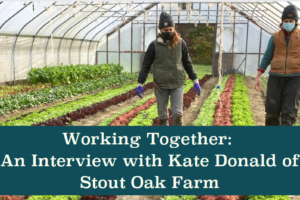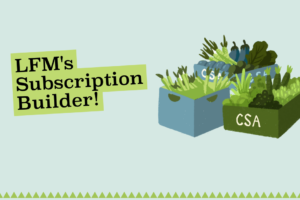Incorporating SMS (short for “short message service”) communication into a farm or food hub’s overall marketing and communication strategy has some clear benefits and is a great addition to your toolbox. Here are some important things to know about communicating via SMS that can maximize your success.
Why SMS Should Be Part of Your Strategy
Why should you consider using SMS at all? Mobile communication is preferred by many consumers and is considered by marketing experts to be highly effective.
Constant Contact shares that the conversion rate for SMS messages is between 21 and 30%, which is up to 10 times higher than the conversion rate for email. Ninety percent of people would rather receive an SMS message than an email or phone call from a company, according to SlickText.com, and around 66% of consumers interact with at least two brands by SMS every week. Your farm or food hub should be one of them!
Perhaps the most important reason to use SMS is it can help your farm or food hub increase sales from your online storefront and increase customer satisfaction.
–Targeted communication with customers and potential customers reminds them you’re there and have something of value to offer.
–Regular updates make shoppers less likely to miss order deadlines, which means you’ll increase customer loyalty.
–Staying in contact with consumers (and doing so in the way they prefer) builds brand loyalty and engagement with your business – leading to higher sales and word-of-mouth referrals over time.
Limitations of SMS
The high ROI of SMS messaging can make it an attractive strategy, but it’s wise not to think of it as the only option for communicating with customers. An integrated messaging strategy is always the most effective. Here are some of the limitations for SMS:
–While some customers like SMS communication, others prefer email or other types of communication. It’s best practice to communicate in multiple ways.
–The brevity of SMS messaging (limit of 320 characters) means it’s not always the best way to share information with customers. Email may be more appropriate when you have a lot of details to share.
–Email or social media may be a better choice when you have information that is best conveyed through pictures, videos, or other graphics.
–SMS messages are typically more expensive than email and other electronic forms of marketing.
–It can be challenging to get customers to opt into receiving SMS messages.
–There is some red tape with SMS. Sending messages requires registration on the Campaign Registry to ensure the business is legitimate and trusted.
Marketing SMS and Transaction SMS
There are different types of business communication using SMS. Each type requires campaign approval; marketing (or promotional) messages requiring some additional information for approval. We’ll focus on marketing and transactional messages here since those have the most widely applicable use cases for farms and food hubs.
Marketing SMS messages are designed to get a customer to take action with your company. Examples supported by LFM include:
–Notifications that ordering has opened.
–Reminders to subscribe to this season’s CSA.
–Notifications that new products have been listed for sale.
–Special offers to entice new customers to take advantage of a sale, purchase a meal kit or other bundle, or increase the size of their order.
On the other hand, transactional SMS are messages related to an order a customer has already placed. Here are some examples of transactional SMS messages that our platform supports:
–Reminders for upcoming deliveries or CSA customization.
–Reminders about unconfirmed orders or abandoned carts.
–Order confirmations or updates.
–Pickup or delivery reminders.
–Critical account issue notifications (for example, an expired credit card).
Local Food Marketplace recently introduced support for SMS directly through our platform. Interested in learning more? Schedule a demo!
Schedule a Demo
Local Food Marketplace recently introduced support for SMS directly through our platform. Interested in learning more? Schedule a demo!
Schedule a DemoTop Five Tips for SMS Messaging
As your farm or food hub determines an SMS strategy, keep these five top tips in mind.
Follow all legal guidelines.
As is the case with email marketing, there are legal requirements that dictate how you can use SMS for marketing. Make sure you understand these laws, which include the following requirements:
–Customers must opt in to receive SMS communication from your company, and there must be an easy way for them to opt out. (LFM automates this process and helps you meet all the requirements.)
–Your online storefront Privacy Policy must meet content requirements. (Our team will provide language for this in the onboarding process.)
–There are limitations on the time of day you can send marketing SMS messages.
Coordinate SMS campaigns into your overall marketing strategy.
Again, SMS is not a one-and-done communication strategy. TextRequest.com encourages marketers to use SMS, emails, and social media posts strategically to make sure messages reach consumers and give them frequent (but not too frequent) reminders about the action the company wants them to take. Make sure all of your marketing outreach is coordinated.
Issue a clear call to action.
Once you understand your goal, issue a clear call to action — which is the action you want people to take. That action may be signing up for this season’s CSA, updating an order, or opting into messages about deals. Be sure this action is clearly stated and it’s easy for people to follow through (usually by providing a link, which is easy to do when you send messages through LFM).
Use data to make your SMS messages effective.
Use the information you collect on customers and potential customers to create SMS messages that are relevant to their needs. This type of targeted communication tends to be much more effective. Here are just a few examples of how you can use data to create messages that are tailored to potential buyers:
–Send past CSA subscribers messages encouraging them to opt back into a subscription for the season.
–Create separate messages for your various customer types (wholesale, retail, CSA, etc.) with order reminders, delivery information, and specials.
–Contact customers in different locations with information about events near them, offers that apply only in their area, or deadlines relevant to them.
Keep it short.
SMS messages are meant to be succinct. Any SMS messages sent through LFM are limited to 320 characters (and ideally no more than 160 characters; longer messages are broken into two messages). People are more likely to read short messages — and people who read and understand them are more likely to respond to your call to action!
Local Food Marketplace recently introduced support for SMS directly through our platform. Interested in learning more? Schedule a demo!
Schedule a Demo
Local Food Marketplace recently introduced support for SMS directly through our platform. Interested in learning more? Schedule a demo!
Schedule a DemoLFM’s SMS Support
LFM’s support for SMS messaging includes the following features:
–Bulk send transactional and/or marketing SMS to customers who have opted into SMS messages.
–SMS message templates for different types of communication.
–SMS log for tracking and viewing SMS messages.
–Account setup guidance, templates for Privacy Policy updates, and other requirements.
Getting Started with SMS on LFM
Convinced you’d like to start using SMS to communicate with your customers? Reach out to LFM today to learn more! We’re happy to walk you through our support for SMS and discuss how you can use your powerful storefront to do it — and so much more.
Request your free demo today!
Schedule a Demo
Request your free demo today!
Schedule a DemoResources cited in this article:
Constant Contact: The Ultimate Guide to SMS Marketing Statistics
SlickText.com: 44 Mind-Blowing SMS Marketing and Texting Statistics
TextRequest.com: 20 SMS Marketing Do’s and Don’ts for Your Text Messaging Strategy




